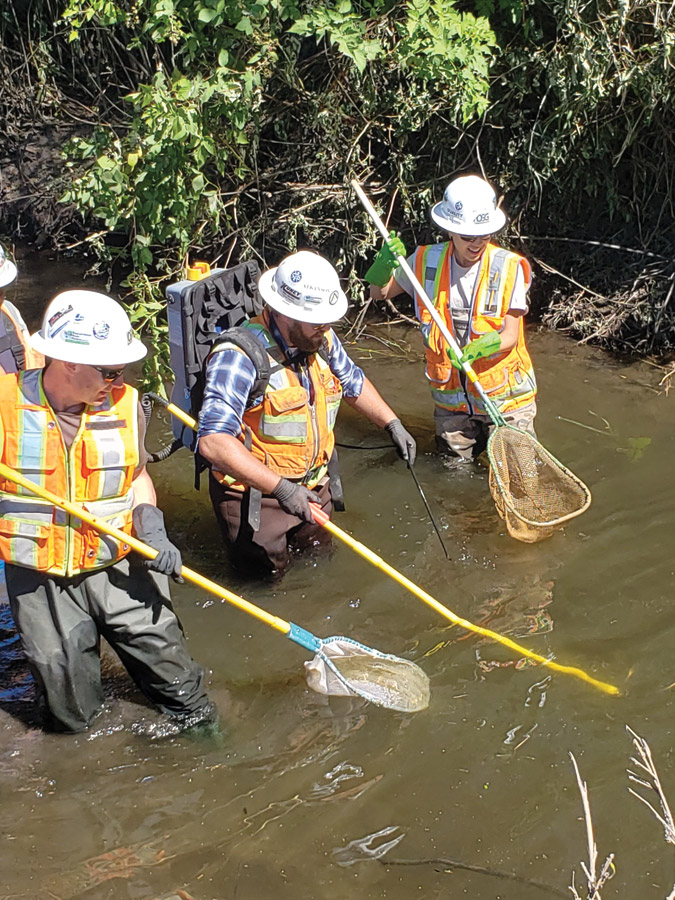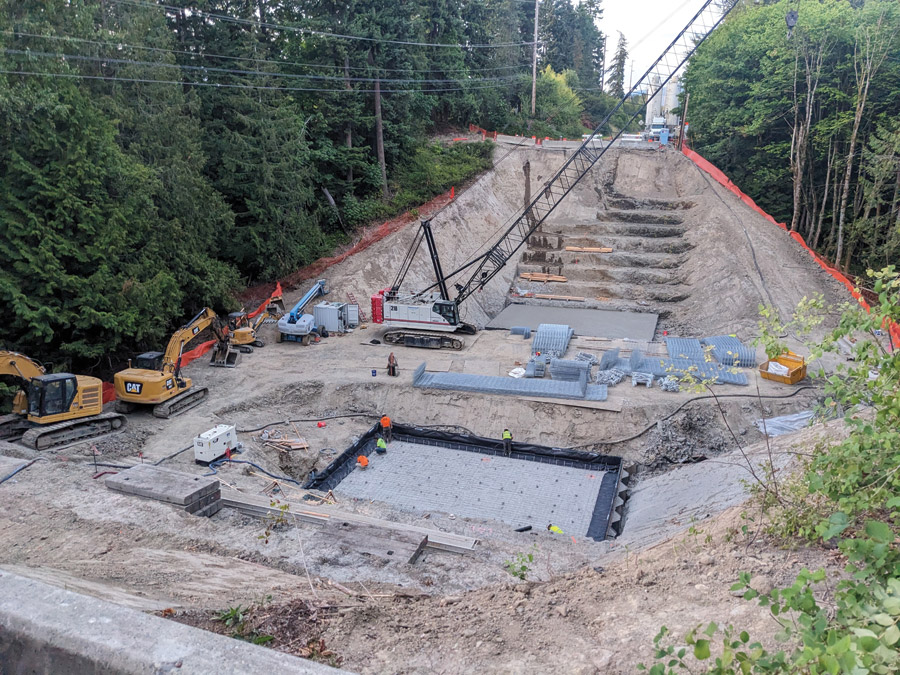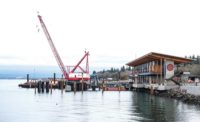Top Starts | ENR Northwest Owner of the Year
WSDOT: Building Relationships With Consistency, Transparency

A March 2024 view of progress on the SR 167 Completion Project at the I-5 intersection, stretching west toward the Port of Tacoma.
Photos courtesy of the Washington State Dept. of Transportation
For more than a decade, the Washington State Dept. of Transportation (WSDOT) has been a leader in delivering everything from megaprojects to small jobs across the Pacific Northwest. And the agency hasn’t slowed pace, even after completing key elements of the Alaskan Way Viaduct Program—including the 2019 opening of the $3.3-billion SR 99 tunnel—and the 2016 rebuild of the world’s-longest floating bridge on State Route 520.
Today, the 119-year-old agency oversees more than 20,000 lane miles of roadway, 3,000 vehicular bridges and an array of rail lines, ferries and airports. On top of that, WSDOT has hundreds of active jobs, including revival projects on Interstate 5 through Seattle, the Alaskan Way Viaduct, bridge work associated with the SR 520 project, mountain pass work as part of the I-90 Snoqualmie Pass phasing and major additions in the I-405/SR 167 project.
For its extensive history of successful big-ticket projects and a stout list of major efforts already coming down the pipeline, plus a commitment to connecting with and helping contractors grow across the region, ENR Northwest has named WSDOT as its 2024 Owner of the Year.

Environmental experts use electrofishing to locate and catch any fish in a small section of Hylebos Creek before restoration and realignment work can begin on the SR 167 Completion Project in Fife, Wash.
Photo courtesy of the Washington State Dept. of Transportation
Connections Matter
The sheer amount of work that WSDOT has underway at the moment has given the agency ample opportunity to connect with the construction industry.
Roger Millar, WSDOT secretary of transportation, says the agency doesn’t want the only interactions with contractors to be when on the clock during a project. That’s why WSDOT meets regularly with the local chapters of Associated General Contractors (AGC) and the National Asphalt Paving Association as well as the trades. He says the agency wants to understand the industry’s issues, follow what’s happening in the market and maintain open lines of communication.
“I think we are willing to listen and to talk, and we work really hard to be fair and reasonable and appropriate in everything we do,” Millar says. “I don’t see this as a zero-sum game with winners and losers. If a project gets built with a fair price and on schedule, I am a happy guy.”
“When working with WSDOT, you know that you are considered part of their team.”
—Ryan Clayton, Civil West Vice President-General Manager, Skanska
WSDOT strives to make it easy for contractors to get involved in the broad decision-making process, says Chris Christopher, WSDOT director of construction. He says the agency works closely with industry teams and if specifications on a project change, they do so in collaboration with the contractor and in advance of the work so there aren’t surprises.
Skanska has partnered with WSDOT since 2010 and currently has a combined $2 billion in road and bridge projects underway, from the I-405 Brickyard to SR 527 project to a new segment of the SR 520 improvement project spanning Portage Bay.
“When working with WSDOT, you know that you are considered part of their team,” says Ryan Clayton, Skanska Civil West vice president-general manager. “It’s a team that is intent on tackling the challenges, not tackling each other.”
Phil Wallace, Kiewit Bridge and Marine senior operations manager, says for as long as he has worked with WSDOT—and he’s done so on megaprojects such as the SR 99 Viaduct demolition and SR 520 Floating Bridge projects—they have been on a mission to be the owner of choice within the construction market.
“I think this is a benefit to both WSDOT and the contractors who work for them,” he says. “Contractors know they will be treated fairly, and WSDOT gets competitive pricing on their projects.”

Crews work to complete a new bridge carrying SR 542 over Squalicum Creek to improve fish passage. The span required more than 16,000 lb of rebar, 12,000 cu yd of concrete and more than 500 tons of asphalt. After a closure of several months, the bridge reopened in October 2023.
Photo courtesy of the Washington State Dept. of Transportation
Flexible Approaches
Having long-standing contractor partnerships has given the agency a lifeline in creating successful megaprojects, says Julie Meredith, WSDOT assistant secretary for urban mobility, access and megaprojects. Bringing contractors in at project inception to get input gives WSDOT the ability to modify approaches if needed and to accommodate contractors and learn from them.
“We try to respond to where the broader market is,” Millar says, noting that many of the delivery methods WSDOT uses come via input from the construction industry. He notes that WSDOT is consistently within 5% on their bid estimates, but when they’ve been off the mark on larger jobs it often had to do with future risks assigned in the contracting type. The agency works with contractors to either go to a progressive model or cut projects into smaller packages. WSDOT has also been willing to share risks on specific projects to make it more favorable for contractors, which results in better bids.
Christopher says WSDOT sees the value of consistency and transparency on large projects and has brought that learning down to smaller projects—even a $500,000 rehab job at a rest area.
“We are taking that and communicating all throughout our leadership team,” he says. “Here’s how we behave as an owner.”
That focus has also led WSDOT to work directly with smaller subcontractors on megaprojects to ensure they feel ready and able to bid on jobs.
These collaborative relationships start early, with a focus on delivering projects on time and on budget. Cohabitating construction teams in the same office as WSDOT is the norm, not the exception. WSDOT values the importance of being accessible at all levels of the organization, Clayton says, noting that Skanska has had multiple informal sessions with WSDOT leaders.
“The contracting industry knows where they will be treated fairly and with respect. WSDOT is that primary destination.”
—Phil Wallace, Bridge and Marine Senior Operations Manager, Kiewit
“They come to the table highlighting their challenges, asking to understand and further explore ours,” he says. “We all walk away committing to solving both sets of challenges together.”
With the upcoming rehabilitation of I-5 through downtown Seattle, Millar knows the agency will need to put into practice all it preaches. “It is truly multidisciplinary,” he says. “We are successful because we value all of those participants. We encourage that engagement.”
The I-5 project isn’t the only headline-grabbing effort. Three new projects were awarded in 2023 as part of the I-405 upgrades, giving that project five active efforts in the 50-mile corridor that has already seen $1.8 billion in work. Key projects include new express toll lanes and bus rapid transit stations.
To upgrade the SR 520 corridor connecting Seattle to points east, the $4.9-billion program moves forward with a $455-million SR 520 eastbound bridge over Union Bay that features a 3-acre lid covering the highway with transit stops and open green space. Upcoming SR 520 projects include the Portage Bay Bridge and Montlake Cut Bridge projects.
Construction is also underway on the I-90 Snoqualmie Pass East Phase 3, part of a four-phase effort that started in 2009 to improve 15 miles from Hyak to Easton. The project has added lanes, avalanche bridges and a wildlife crossing.
Meanwhile, WSDOT’s Fish Passage Program continues to correct barriers preventing native fish from reaching their natural habitat. As of June 2023, 114 fish barriers were corrected, opening 502 miles of fish habitat. The program is now on track to have roughly 300 corrections under construction contract by December, which will represent about 80% of necessary work.
For years, Washington’s state Legislature has stood out among Northwest states as being especially focused on prioritizing investments in major transportation upgrades. The result has been that most of the region’s megaprojects have been located in the Evergreen State. Plus, Sound Transit has been growing at a record rate, while spending at local ports is also on the rise.
While Washington has been the place to be in the Pacific Northwest in terms of large-scale construction projects, now that an increased amount of federal money is flowing through the entire region, contractors have a larger menu to choose from, Millar says.
“It has been important to us when they have that many choices to be the agency they choose to work with,” he adds.
Wallace believes that other large owners in the Seattle area could learn a lot from WSDOT on how to form contractor partnerships.
“The contracting industry knows where they will be treated fairly and with respect. WSDOT is that primary destination,” he says.




